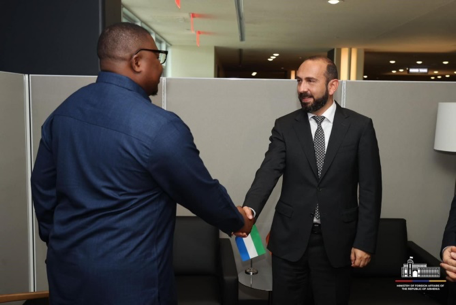
By: Mohamed Jalloh
Within the framework of the 79th session of the UN General Assembly, Minister of Foreign Affairs of the Republic of Armenia Ararat Mirzoyan had a meeting with Timothy Musa Kabba, the Minister of Foreign Affairs and International Cooperation of Sierra Leone.
The interlocutors discussed international and regional security issues, taking into account Sierra Leone’s election as a non-permanent member of the UN Security Council and the UN Security Council’s mandate to maintain international stability and peace, the Armenian Foreign Ministry said in readout.
Minister Mirzoyan presented Armenia’s vision for establishing stable, just and comprehensive peace in the South Caucasus, including the importance of signing the peace treaty with Azerbaijan and the efforts being taken in that direction.
The Foreign Ministers of Armenia and Sierra Leone also touched upon the prospects of the development of relations between the two countries in various fields, taking into account the interest of Armenia in expanding partnership with the countries of the African continent. In late 2023, some believed such a historic step was just around the corner following Azerbaijan’s full seizure of the disputed region of Nagorno-Karabakh, but nothing materialized. At the same time, the outlines of a possible treaty are emerging, along with an understanding of what it would require from the two parties.
Claims that a landmark treaty between Armenia and Azerbaijan is imminent have been made so often in recent years that they now attract little attention. A breakthrough was expected at the end of 2022, then the spring of 2023, and in the fall of 2023, when Baku’s seizure of Nagorno-Karabakh finally put an end to their long-running territorial dispute.
On the most recent occasion, optimism ran particularly high. Armenia and Azerbaijan even released a joint statement, which was characterized as “historic” and “unprecedented.” Yet discussions about territorial integrity and a prisoner exchange did not lead to any substantive achievements. There also appeared to be few concrete results from a reciprocal gesture of goodwill in which Armenia withdrew its candidacy to host the next United Nations Climate Change Conference (COP29), and Azerbaijan supported Armenia’s inclusion in COP’s Eastern European States grouping.
There were some hopes invested in a meeting between the Armenian and Azerbaijani foreign ministers in Washington that was planned for January. But it’s now clear the encounter will not take place. Indeed, Azerbaijan is striving to achieve the “sovereignization” of the conflict by refusing offers of mediation by third countries. There is also growing bad blood between both Baku and Paris, and Baku and Washington.
Nevertheless, a peace treaty remains possible, and its significance should not be downplayed. In all likelihood, any agreement reached would be a framework requiring additional negotiations in subsequent years.
Following Baku’s military takeover of Nagorno-Karabakh and the flight of the region’s Armenians, the main points of dispute concern enclaves, transport links, and the delimitation of borders. While there remains little clarity on these issues, the two sides are finally saying some obvious things out loud.
Above all, both Baku and Yerevan have conceded that the delimitation of their shared border will have to take place after the conclusion of a peace treaty. This admission smooths the path to a treaty because ratifying such a border, which passes over mountain ranges, will take many years. A similar process between Azerbaijan and Georgia remains incomplete, despite the two countries being at peace.
The Armenians would like to use military maps from the 1970s as the basis for a border agreement. In contrast, Baku wants experts to map the situation on the ground and use that as the basis for a permanent settlement. Baku’s approach means Azerbaijan retaining many strategic positions. In addition, President Ilham Aliyev has said that the Azerbaijani army will not retreat from positions it seized during bouts of fighting in May 2021 and September 2022—even if they are on Armenian territory.
Nevertheless, the suggestion to examine the border without referring to old maps is not entirely unconstructive. If the two sides were ready to exchange territory and make some concessions, the situation could be ameliorated. But experience suggests this is unlikely: instead, the stronger Azerbaijan will seek to press Armenia into a corner. Accordingly, unless Armenia and Azerbaijan are prepared to set aside border delimitation for a later date, the chances of signing a peace treaty are almost nil.
Another issue on which the two sides appear to be converging is transport corridors. By stating it will build a road via Iran—not Armenia—to its exclave of Nakhichevan, sandwiched between Armenia and Turkey, Azerbaijan has made a significant concession.
Not only has Aliyev publicly announced that the construction of the Iran route is already underway, but he has also named his price for ditching the Armenian route (also known as the Zangezur Corridor): that Azerbaijan will not open its border with Armenia. Even the possibility of Azerbaijan renouncing its claim to the Zangezur Corridor is a positive development. As recently as 2021, Aliyev was threatening to carve it out using military force.
Azerbaijan’s readiness to accept the Iran route could even elicit support in Moscow, which has long been seen as a backer of the Zangezur Corridor. Above all, Russia is interested in restoring its rail connections with Iran and Turkey that existed in Soviet times, and either route would work for those purposes.
If there is no backsliding and Baku is really happy to give up on the Zangezur Corridor in return for keeping its border with Armenia closed, then peace will be much closer. The idea of an Azerbaijani transport artery bisecting Armenian territory has only ever sparked fears in Yerevan that it could lead to their losing control of the southern Syunik region.
One possible model for relations between Armenia and Azerbaijan is that of Armenia and Turkey from 1993 to the present: a closed border, no diplomatic ties, hostile rhetoric, and history textbooks that preach eternal confrontation. At the same time, however, Armenia and Turkey do not have any territorial claims against one another, and there have been no military engagements—or deaths—in that period.
There are other “successful” examples of such icy standoffs in international relations: Israel and Egypt, or Israel and Jordan. If this is the outcome for Armenia and Azerbaijan, it means their shared border could be opened in fifteen or twenty years: a relatively short time by historical standards. Pushing for it to happen any sooner risks triggering instability.
In the final analysis, it’s Azerbaijan that has the most power to determine whether a landmark peace agreement is within reach. For Baku, the choice comes down to either signing a framework treaty to shore up its international prestige or sabotaging the process to justify a military escalation further down the line. Baku’s calculations about which route to take will depend primarily on external circumstances.

